I’ve played through several endings of The Dark Pictures Anthology: Man of Medan, and I’m going to play more until I get the ending just right. In this post-World War II era horror game set aboard a derelict freighter, your job is to make sure that all five characters come back alive — no matter how annoying they are.
Man of Medan is one of multiple installments in The Dark Pictures Anthology, and it’s the latest horror game to come from Supermassive Games — the makers of Until Dawn, my favorite title of 2015. Medan debuts on the PlayStation 4, Xbox One, and Windows PC on August 30. This time it comes with a multiplayer mode: Shared Story, where you can play in the same story with another human player, who controls a different character among a group of playable characters. The game also has a Movie Night mode, where up to five people can pass the controller around, taking turns controlling one character each.
These new modes make the game a lot more social and live up to the legacy of innovation at Supermassive Games. And while this game has fewer main characters — five compared to eight — than Until Dawn, it’s not easy to keep them alive. You face many more branching paths, and those five characters can die in 69 different ways.
Warning: This review contains some spoilers.
June 5th: The AI Audit in NYC
Join us next week in NYC to engage with top executive leaders, delving into strategies for auditing AI models to ensure fairness, optimal performance, and ethical compliance across diverse organizations. Secure your attendance for this exclusive invite-only event.
Check out our GamesBeat review vault for past reviews.
What you’ll like
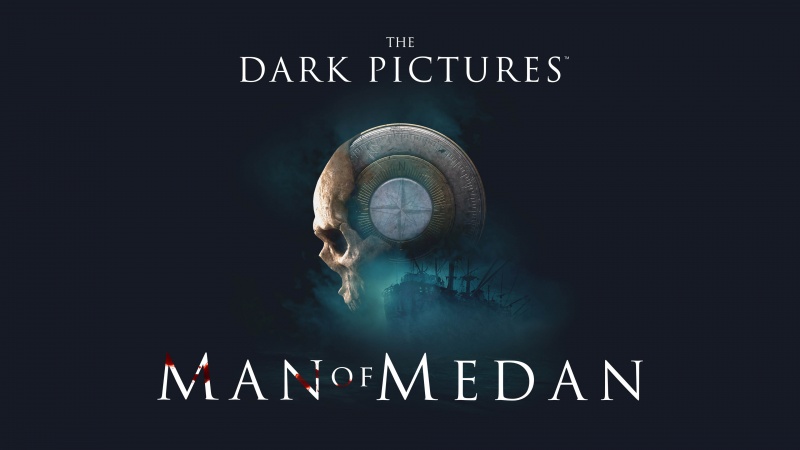
Above: Welcome to Man of Medan, the first game in The Dark Pictures Anthology.
A haunting story
The game started with a very strange hard rock song. But if you can get over that, then pay attention to a British gentleman who strolls down a hallway of pictures. Those pictures will become very significant as you play the game. The man introduces himself as the Curator, and he strikes me as a manifestation of The Fates, telling you that your decisions will determine life or death.
He narrates the story, and he will appear in between the major acts of the narrative. He will reprise the role in each of the five or more stories in The Dark Pictures Anthology, of which Man of Medan is only one. The Curator (played by Pip Torrens) tells us how important our decisions will be, and how pictures hanging on a wall can give us a little premonition of what will come next in the story. If you read the premonitions correctly, you can avoid a disastrous fate.
Pete Samuels, CEO of Supermassive Games, told me in a recent interview that the game is based on a “true story,” or rather a myth, about a ghost ship called the SS Ourang Medan, which was said to be a derelict ship floating in the South Pacific with a dead crew. (Supermassive has a habit of basing its stories on legends of the past; Until Dawn was also based on the Wendigo creatures of Native American stories).
The game is loosely based on the Ourang story (Ourang translates in Indonesian to man, and it presumably means a man from the city of Medan). The prelude starts with a couple of drunk U.S. Army soldiers who are celebrating their shore leave at a port in China. You learn how to control the characters in a short tutorial where the soldiers interact in a kind of street carnival. Then the soldiers rush aboard their freighter, dubbed the Man of Medan.
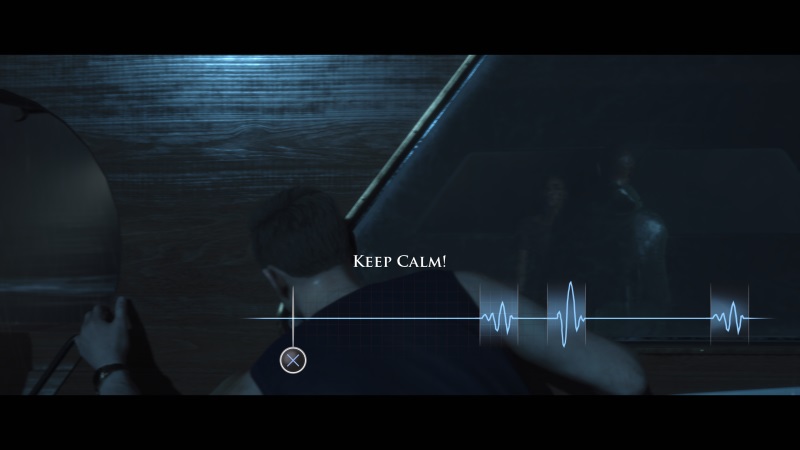
Above: If you miss a beat in the heartbeat mechanic, you’ll give yourself away.
The soldiers get into a fight with an officer aboard the ship, and they’re thrown in the brig. They wake up and find that the ship is in a very bad state. Some mysterious acid has leaked and mixed with water to form a toxic gas that affects the crew and the bodies of some soldiers in caskets. The two soldiers — now controlled by each human player — discover that the crew has gone mad and has begun shooting each other.
The soldiers try to escape and start wandering through the ship. You can hide, and then you have to control your breathing as another deranged soldier runs by. You have to tap the controller at the right time, a la Guitar Hero, to control your breathing. I really liked this mechanic, as you had to match your button pushes to the sound of a heartbeat of a terrified person.
Playing as one of the soldiers, I picked up a machine gun and then a kid ran by me. He hid in a locker. I fired into the locker, and then opened it. The kid transformed into some kind of zombie, and then I died. During this prelude, or tutorial, I figured out that you can’t survive. I paid close attention because I figured the prelude would give me a lot of hints about the main story.
Five distinct characters, some worth saving

Above: The five main characters of Man of Medan.
The story flashed forward to the modern day, as a group of young adults board a tour boat at a dock. They include the beefy Alex (played by Kareem Tristan Alleyne), his nerdy younger brother Brad (Chris Sandiford), the tough captain Fliss (Ayisha Issa), the spoiled rich woman Julia (Arielle Palik), and her annoying brother Conrad (Shawn Ashmore). Alex is thinking about the right moment to do something important with Julia, and this moment may or may not come during the game scenes.
As with Until Dawn, Man of Medan is rendered in a cinematic art style, with amazingly realistic, motion-captured human faces and bodies. It’s almost like being inside a supernatural horror movie, where you can play the characters in the film. But in contrast to a film, you get to make choices that determine the sequence of events and the ultimate fate of the characters.
Right away, you’ll notice the characters have very different personalities. Conrad is the rich playboy who likes to party and drink. His sister Julia is less annoying but still a bit of a primadonna. Alex is on edge about his pending wedding proposal to Julia. Brad is the awkward nerd, and Fliss gravitates from going by the book to having fun. Of that group, I only like Alex, Brad, and Fliss. But in the game, that doesn’t matter. What matters is what they think of each other, and whether they will make the right decisions to save each other’s lives when it really matters.
More precise character control

Above: Do you know Fliss well enough?
As the player, you control all of the characters at one time or another. The control shifts to different characters as the plot advances. You can see the nature of the relationships clearly as you make the choices, either with your head or with your heart. A meter will show whether your relationship with one character is strengthening or weakening. You can also get to see the personality of the character you are playing change.
They board the boat and take off on the open sea. You start making small decisions during the journey. Playing as Alex, you can decide whether or not to accept a beer from Conrad. You can refuse and watch Conrad get moody. Or you can accept, and pay the consequences of getting sick. As you make these decisions, your traits are updated. You can become aggressive, impatient, or daring. And these traits will change the options that are available to you when you have to outwit an unstable opponent or have to make a split-second decision to run or fight.
The Dark Pictures
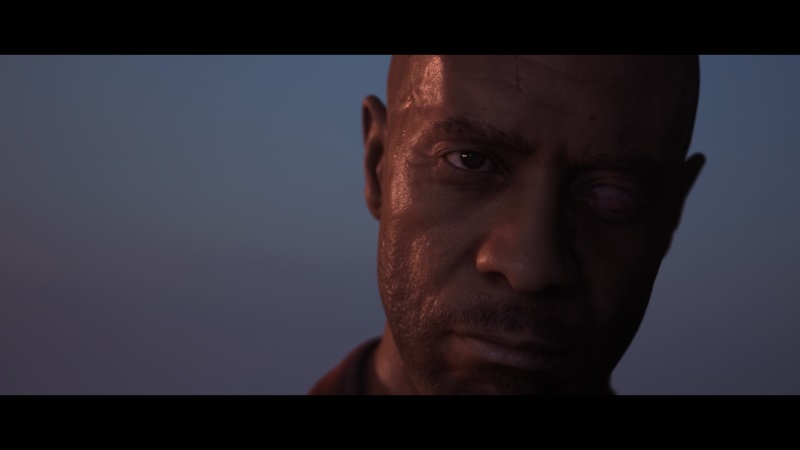
Above: Olson is not one of the nice guys in Man of Medan.
You do get some help. The Curator himself will drop a clue for you, if you choose to accept it. And then you have The Dark Pictures. When you come across a painting, you can choose to view it. As you do, it reveals a short scene to you. You can’t tell exactly what is going on, but will be a glimpse of a life-or-death situation for one of the characters or something very important that could or will happen in the future. Sometimes, the scene is a death scene, and you might think it is inevitable.
But those premonitions can help you make better decisions. With these small decisions, you set up the relationships between the characters. These lead to bigger decisions as well as action sequences with QuickTime events where you have to mash the correct key on the controller at the right time.
You have to make your decisions as if your life is at stake. But whether answering sincerely or flippantly is the best choice is never obvious. In this game, all playable characters can live or die. As mentioned, you can encounter 69 different scenarios where characters can die in Man of Medan. The story forces you to make choices that can mean life or death for your character.
Difficult dilemmas
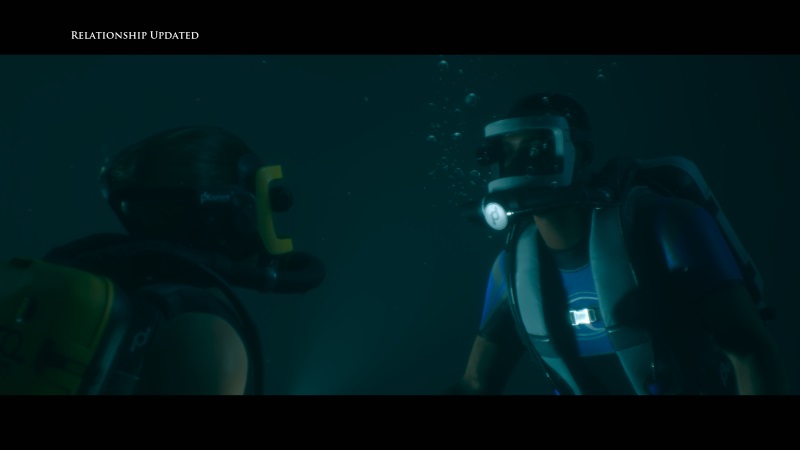
Above: Decision point in Man of Medan.
When the game puts you in a touch situation, it doesn’t necessarily judge you. You can wander through the boat in search of small clues, like why Fliss’ identification seems sketchy and why a book in a closet features a creepy guy with a hood .
Of course, the game developers steer you into making some bad decisions. Brad has figured out where they might find a World War II airplane wreck. They go to that spot and an underwater camera shows that Brad’s calculations are correct. Julia and Alex plan to dive down to the wreck. Fliss warns they should go by the book, reporting the find and not disturbing anything.
But Julia insists on diving, and, as Alex, you can agree with her wholeheartedly or sympathize with Fliss. In any case, the duo dives down to the wreck. They find the intact rescue plane from the World War II era. They dive inside, disturb a lot of the innards, and make some discoveries. As they emerge, Alex has a moment where he wonders whether to tell Julia his big secret.
But they see an explosion on the boat from below, and they have to decide whether to rush up or not. If they rush, they run the risk of decompression sickness, which can be life threatening. I chose to go up fast. When we got up there, a motorboat sped off. Conrad says sheepishly that they had a barbecue mishap, which caused the explosion.
The boat carried some thug-like guys who were insulted by Conrad. And those thugs come back, triggering much of what happens next in the story.
Thinking quickly
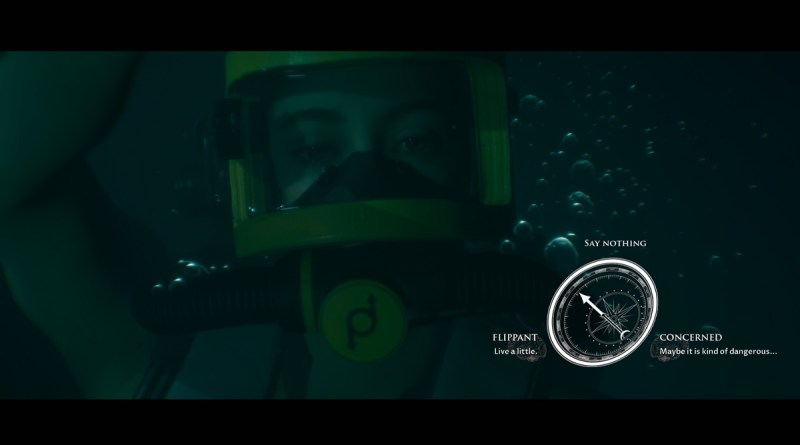
Above: Decisions, decisions.
At night, the group is sleeping in the tour boat, still on the open sea. A storm approaches, and the three bad guys return, board the boat, and take our sleepers by surprise (yes, you don’t have te choice to post a guard at night). They pull out guns and knives and tie up the five crewmates. They step outside and leave the tied-up youngsters inside the cabin.
That’s when I had to collaborate with my co-op player. I controlled Alex, and he controlled Conrad. We had to make decisions quickly, like figuring out how to untie a character. I had a choice to talk or untie. I chose to untie, and then a bad guy walked in and took Fliss and then Conrad out. The bad guy beat up Conrad, which was distressing for Julia.
We tried to push out the window of the cabin, but I forgot to time it to the sound of lightning. So the guard heard us and came in. We had some chances to fight and gain the upper hand, but I failed about half of the QuickTime events, which came and went fast. I finally wrested a knife from one of the guards, but I was discovered. Then the chief bad guy pointed his gun at Julia. I had to back down and give up my knife.
My co-op player had to choose, as Conrad, whether to go for a gun or try to escape over the side in the motorboat. He chose to stay with me and try to grab the gun. He failed, but the guards didn’t shoot us. With that, the gameplay session came to an end.
I found out later that Conrad could have died if he made it to the boat and if I also failed to distract the shooter.
Movie Night mode
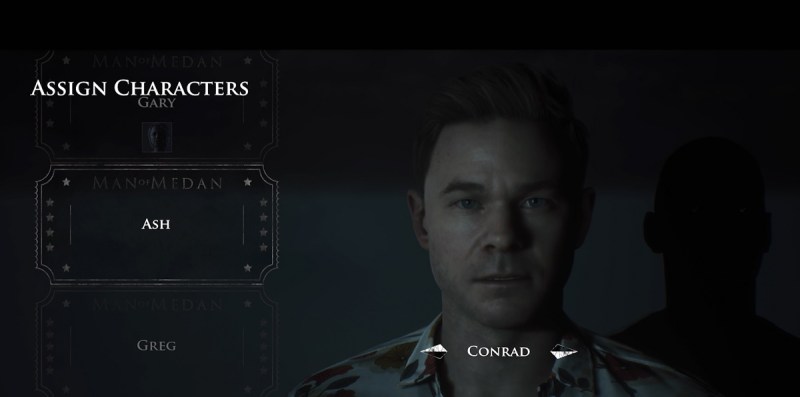
Above: Can you get to know Conrad better?
I also played the same scene in Movie Night mode, where up to five players can play one character and pass the controller around as other characters become active. Several of my human colleagues played with me. We talked over the things that happened in our first playthrough, and we got started on a second. We talked about the decisions we made and how the outcomes in our second playthrough were different.
Movie mode definitely showed me how fun it could be to play in a group, as it was with Until Dawn.
Going back to replay the game
This is one of those rare games where it pays to play it repeatedly. In my first playthrough, I made it through the story with only one death. But that didn’t mean I had to waste my time going all the way back to the beginning. You can go into the Scene Selection feature and choose where to begin again. After you finish your first game, you’ll see 24 or so scenes listed. You can go back to one of them and start a New Save. When you do so, you are picking up at a key point in the story. Then you can replay it and have a different outcome. Of course, sometimes you have to go back farther, and that might just necessitate an entirely fresh game. But for the most part, the key decision points take place in the second half of the game.
What you won’t like

Above: Every decision carries weight in The Dark Pictures Anthology: Man of Medan.
Have I seen this game before?
If you’ve played Supermassive’s other games (Until Dawn and Hidden Agenda in particular), then you’ll know that the universe is merciless. Some decisions are big. Some are small. Maybe you can avoid your fate. But your collective decisions will matter. Man of Medan is another game in a series that invokes the “Butterfly Effect,” or the chaos theory idea that suggests a small change in a system’s initial conditions can result in huge variations in a later state. The name was coined by Edward Lorenz, and it comes from an example where the flapping of a butterfly’s wings can cause subtle changes that affect the path of a hurricane weeks later. In the game, your smallest and biggest decisions can affect the outcome. If you have played the other games, you have a sense of foreboding. You know you must make the right choice, and that in itself affects the choices you make. For instance, you could drink a beer, but is that really going to help you in a life or death situation? So you’re probably not going to drink that beer, because you know you are in a horror game.
Random deaths
Yes, just as we saw in Until Dawn, sometimes characters are simply doomed for no reason. You may be in a do-or-die situation, and you can only figure out how to save the character through trial and error. You have to replay the game to figure this out, and this very annoying. Maybe some logic determines why one character will survive in a situation and why another will die in the exact same situation. But you only find this out in hindsight. I wish the universe were more just and fair. But then, this is a video game where the developers are the gods.
Unforgiving twitch decisions
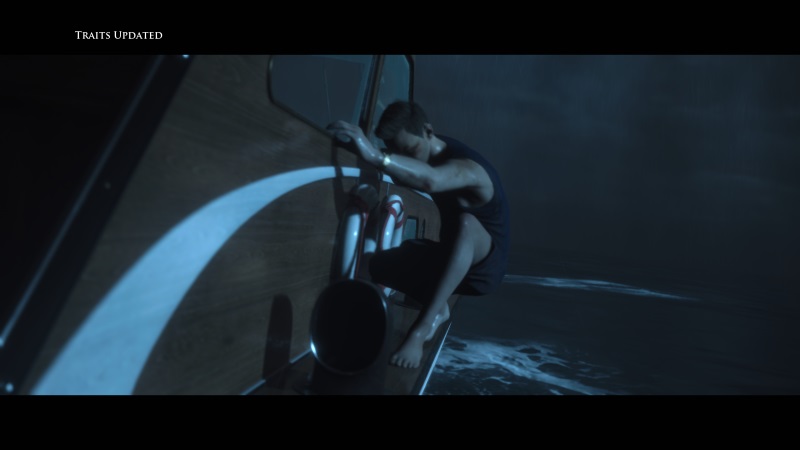
Above: Will Conrad save the day or slip into the ocean?
At many points in the game, you have to be ready to press a button fast and sometimes repeatedly to avoid having a character die. And obviously when that happens, you can’t rewind time and bring that character back. The dead are dead. I suppose this mimics real life. When we’re in an emergency, it unfolds quickly, and we are rarely prepared for it. But I wish that we had just a split-second longer to save the day when the button mashing has such high stakes.
Clunky movement
While the 3D characters look amazingly realistic, they move slowly. It is hard to maneuver them through a room, since they engage in weird combination of 2D and 3D when it comes to movement. You often have to wait for them to complete their movements before you initiate the next movement. And you often waste time when you run into dead ends and have to turn around. I hope this is the last we see of this high-latency game engine, and that the next versions will be much more fluid. I’m almost willing to get a game with lesser graphics quality if it means better motion and interactivity.
Relatively short story
While Man of Medan is a standalone story, it does feel short at just a few hours long. Until Dawn felt like it had a bit more heft, with the chance to get to know some of the characters better. I would have enjoyed playing a game that went deeper into each character’s background and motivations. In that way, this game feels a bit more like a chapter in an anthology, rather than a full game unto itself.
Conclusion
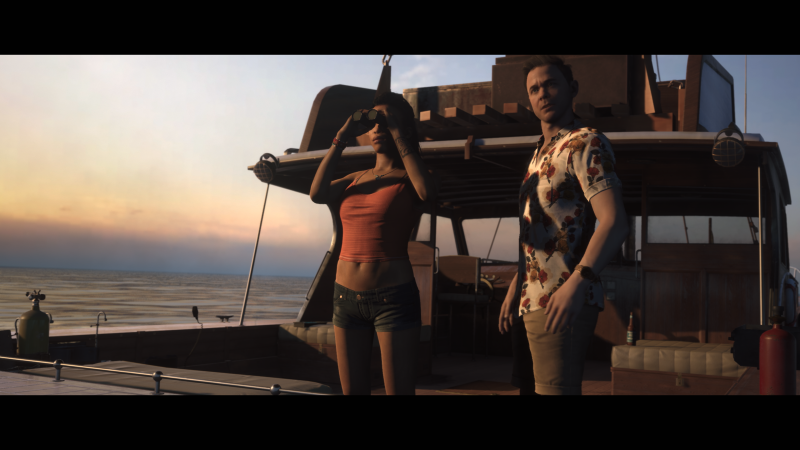
Above: Trouble is coming.
After playing Until Dawn in 2015 and Hidden Agenda in 2017, I was wondering if Supermassive’s single-player horror games were going to become stale. But with the multiplayer mode in Man of Medan, the experience seems much more fresh, as you now have to figure out if your human comrade is going to stick with you or screw you over. If your colleague is a coward, you may die. The Movie Night feature also makes it even better as a party game.
I think this is much more fun and takes advantage of the fundamentally social nature of the choose-your-adventure style gameplay in Man of Medan.
Overall, I think The Dark Pictures is very spooky, and the sense of fate that comes with it is very compelling. I think it was very smart for Supermassive Games to build a whole horror series around this concept. I’m looking forward to the next one, but I also hope that the graphics and gameplay will strike a better balance so that it’s more interactive.
Score: 88/100
The Dark Pictures Anthology: Man of Medan is available on August 30 on the PlayStation 4, Steam, and Xbox One. The company provided GamesBeat with a copy of the game for this review.

